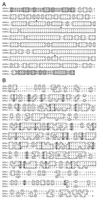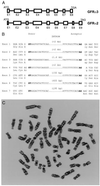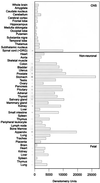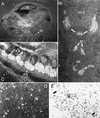GFRalpha3 is an orphan member of the GDNF/neurturin/persephin receptor family
- PMID: 9576965
- PMCID: PMC20460
- DOI: 10.1073/pnas.95.10.5801
GFRalpha3 is an orphan member of the GDNF/neurturin/persephin receptor family
Abstract
GDNF, neurturin, and persephin are transforming growth factor beta-related neurotrophic factors known collectively as the GDNF family (GF). GDNF and neurturin signal through a multicomponent receptor complex containing a signaling component (the Ret receptor tyrosine kinase) and either of two glycosyl-phosphatidylinositol-linked binding components (GDNF family receptor alpha components 1 and 2, GFRalpha1 or GFRalpha2), whereas the receptor for persephin is unknown. Herein we describe a third member of the GF coreceptor family called GFRalpha3 that is encoded by a gene located on human chromosome 5q31.2-32. GFRalpha3 is not expressed in the central nervous system of the developing or adult animal but is highly expressed in several developing and adult sensory and sympathetic ganglia of the peripheral nervous system. GFRalpha3 is also expressed at high levels in developing, but not adult, peripheral nerve. GFRalpha3 is a glycoprotein that is glycosyl-phosphatidylinositol-linked to the cell surface like GFRalpha1 and GFRalpha2. Fibroblasts expressing Ret and GFRalpha3 do not respond to any of the known members of the GDNF family, suggesting that GFRalpha3 interacts with an unknown ligand or requires a different or additional signaling protein to function.
Figures






Similar articles
-
Expression and regulation of GFRalpha3, a glial cell line-derived neurotrophic factor family receptor.Proc Natl Acad Sci U S A. 1998 Feb 3;95(3):1295-300. doi: 10.1073/pnas.95.3.1295. Proc Natl Acad Sci U S A. 1998. PMID: 9448325 Free PMC article.
-
Mammalian GFRalpha -4, a divergent member of the GFRalpha family of coreceptors for glial cell line-derived neurotrophic factor family ligands, is a receptor for the neurotrophic factor persephin.J Biol Chem. 2000 Dec 15;275(50):39427-34. doi: 10.1074/jbc.M003867200. J Biol Chem. 2000. PMID: 10958791
-
GFR alpha-4 and the tyrosine kinase Ret form a functional receptor complex for persephin.Curr Biol. 1998 Sep 10;8(18):1019-22. doi: 10.1016/s0960-9822(07)00422-8. Curr Biol. 1998. PMID: 9740802
-
GDNF - a stranger in the TGF-beta superfamily?Eur J Biochem. 2000 Dec;267(24):6968-71. doi: 10.1046/j.1432-1327.2000.01826.x. Eur J Biochem. 2000. PMID: 11106404 Review.
-
Novel functions and signalling pathways for GDNF.J Cell Sci. 2003 Oct 1;116(Pt 19):3855-62. doi: 10.1242/jcs.00786. J Cell Sci. 2003. PMID: 12953054 Review.
Cited by
-
Persistent restoration of sensory function by immediate or delayed systemic artemin after dorsal root injury.Nat Neurosci. 2008 Apr;11(4):488-96. doi: 10.1038/nn2069. Epub 2008 Mar 23. Nat Neurosci. 2008. PMID: 18344995 Free PMC article.
-
Conformationally Restricted Glycopeptide Backbone Inhibits Gas-Phase H/D Scrambling between Glycan and Peptide Moieties.J Am Chem Soc. 2023 Nov 8;145(44):23925-23938. doi: 10.1021/jacs.3c04068. Epub 2023 Oct 26. J Am Chem Soc. 2023. PMID: 37883679 Free PMC article.
-
Rac1 is a critical mediator of endothelium-derived neurotrophic activity.Sci Signal. 2009 Mar 10;2(61):ra10. doi: 10.1126/scisignal.2000162. Sci Signal. 2009. PMID: 19278959 Free PMC article.
-
Biomaterials in cochlear implants.GMS Curr Top Otorhinolaryngol Head Neck Surg. 2009;8:Doc10. doi: 10.3205/cto000062. Epub 2011 Mar 10. GMS Curr Top Otorhinolaryngol Head Neck Surg. 2009. PMID: 22073103 Free PMC article.
-
Targeting eNOS and beyond: emerging heterogeneity of the role of endothelial Rho proteins in stroke protection.Expert Rev Neurother. 2009 Aug;9(8):1171-86. doi: 10.1586/ern.09.70. Expert Rev Neurother. 2009. PMID: 19673606 Free PMC article. Review.
References
-
- Lin L-F H, Doherty D H, Lile J D, Bektesh S, Collins F. Science. 1993;260:1130–1132. - PubMed
-
- Kotzbauer P T, Lampe P A, Heuckeroth R O, Golden J P, Creedon D J, Johnson E M, Milbrandt J D. Nature (London) 1996;384:467–470. - PubMed
-
- Milbrandt J, de Sauvage F, Fahrner T J, Baloh R H, Leitner M L, Tansey M G, Lampe P A, Heuckeroth R O, Kotzbauer P T, Simburger K S, et al. Neuron. 1998;20:245–253. - PubMed
-
- Stromberg I, Bjorklund L, Johansson M, Tomac A, Collins F, Olson L, Hoffer B, Humpel C. Exp Neurol. 1993;124:401–412. - PubMed
-
- Hudson J, Granholm A-C, Gerhardt G A, Henry M A, Hoffman A, Biddle P, Leela N S, Mackerlova L, Lile J D, Collins F, Hoffer B J. Brain Res Bull. 1995;36:425–432. - PubMed
Publication types
MeSH terms
Substances
Associated data
- Actions
- Actions
Grants and funding
LinkOut - more resources
Full Text Sources
Other Literature Sources
Molecular Biology Databases

